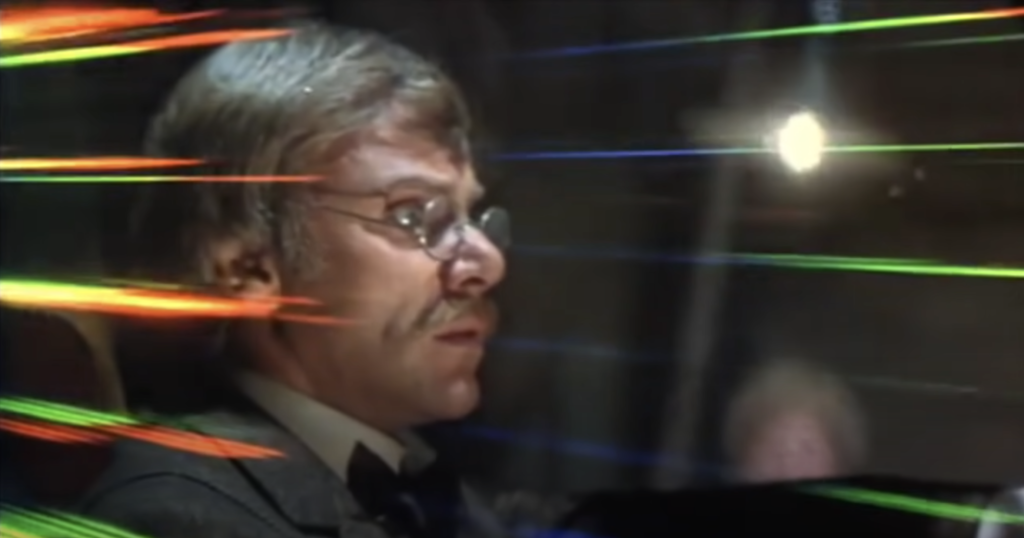Directed by Nicholas Meyer, screenplay by Meyer from a story by Steve Hayes based on the novel by Karl Alexander
Time After Time was a high concept movie before the term was in common use. For those not in the know, “high concept” refers to a story with a quick and easy hook, and Nicholas Meyer’s directorial debut has a doozy: Jack the Ripper uses H. G. Wells’ time machine to flee to our time, and only Wells can stop him.
If that doesn’t make you want to see Time After Time, there is more. Malcolm McDowell and David Warner are perfectly cast as Wells and Dr. Stevenson, aka Jack the Ripper. Mary Steenburgen is a delight as Amy Robbins, a banker Wells meets in 1979 San Francisco. She plays Robbins with a gentle touch—vulnerability undergirded by an assertive personality. The great Miklós Rózsa provides a nostalgic music score straight from the 1940s. Time After Time also features a classic Meyer screenplay featuring roundly drawn characters who occasionally make dumb decisions populating three tight acts that hurtle from scene to scene.
That would be enough, but there is another layer. Wells and Stevenson are friends in Victorian England, where they play chess and debate the nature of man. Wells believes humankind will evolve into a socialist utopia. Stevenson is more cynical—he knows the evil that lurks in men’s hearts. When Stevenson escapes a police dragnet using Wells’ time machine (a steampunk marvel that looks like a larval version of Nemo’s Nautilus), Wells fears he has unleashed a monster into a perfected future. Instead, he quickly realizes San Francisco of the late 1970s is anything but. When he corners Stevenson, the serial killer turns on the TV, which displays a parade of war, crime, and bloodhsed. “Ninety years ago, I was a freak,” he intones. “Today, I’m an amateur.” And so their struggle is as much a battle over ideas.
Meyer’s direction shows some rawness, but he also has his moments of inspiration. Wells’ first ride in a motor vehicle plays out from his point of view, with the cab seemingly careering down the street at breakneck speed. Wells learns there were two World Wars (much to his disappointment) from a pawnbroker who bears a concentration camp tattoo. The number on his arm is never explained to Wells, which makes the detail more powerful. When Wells first meets Amy Robbins, he asks for a gentleman banker, to which Amy asks why he doesn’t believe in women’s liberation. “I was all for it!” Wells smiles, to which Amy retorts, “What changed your mind?” And it’s no small detail that Wells remains in his Victorian tweed suit while Stevenson quickly trades his starched collar for a current suit of clothes. He truly belongs here.
Along with Capricorn One and Topkapi, Time After Time was a movie that inspired me to explore filmmaking as a vocation. Capricorn One displayed what a director could do with visuals and rhythm. Topkapi created captivating characters in intriguing set pieces. Time After Time showcased the power of a great script. Meyer’s screenplay has a model three-act structure with crisp dialogue and arch humor. The movie also plays with the time paradox—Wells takes Amy a few days into the future to prove his story to her, only to find she will be the Ripper’s next victim. Their next move is to figure out how to change the newspaper headlines—if they can be changed.
Most of all, Time After Time is a delightful romp with a killer elevator pitch. In an age where “high concept” films often fail to deliver narrative substance on the skeletons of their amazing hooks, Time After Time gives you both. There’s enough cinema here that I watched it over and over—on TV, then VHS. Did I say over and over? I meant—well, you know what I mean.

